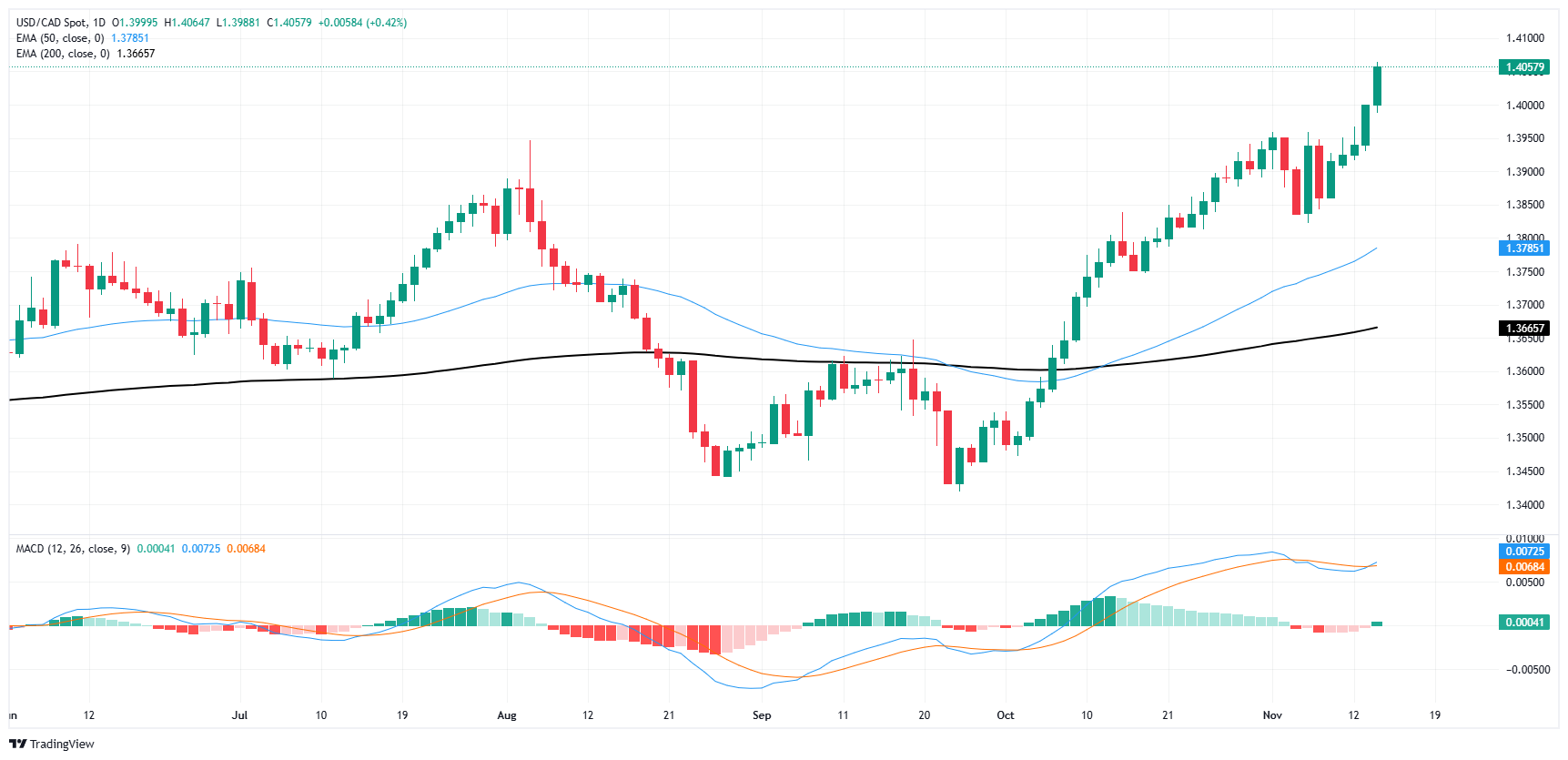- The Canadian Dollar found new lows against the Dollar on Thursday.
- Canada remains largely absent from the economic calendar until next week.
- US PPI inflation accelerated more than expected for the year ending in October.
The Canadian Dollar (CAD) retreated to new lows against the Dollar on Thursday, falling to a new 54-month low and sending the USD/CAD pair to its highest prices in four and a half years. The pair broke the 1.4000 level, with the US Dollar rising further due to a slight increase in the US Producer Price Index (PPI) inflation figures on Thursday, sending the CAD to multi-year lows .
Canada remains absent from the economic calendar this week with a notable lack of significant data releases on the radar. CAD traders will be forced to wait until the Canadian Consumer Price Index (CPI) inflation update for October next Tuesday, which probably won’t bring much good news for CAD followers.
Daily Market Summary: Canadian Dollar Hit by US Producer Inflation
- The Canadian Dollar found a new four-and-a-half-year low against the Greenback on Thursday, falling to its lowest bids against the safe-haven US Dollar in 54 months.
- US PPI inflation accelerated a little more than expected in October, keeping investors cautious and reminding them that extremely low interest rates are much easier to wish for than to achieve.
- US core PPI inflation for the year ended October rose 3.1% year-on-year, higher than the 3.0% forecast and rising further from the previous period’s revised 2.9%, which was initially printed at 2.8%.
- Canadian CPI inflation data due next week likely won’t bring much good news for CAD bulls as inflation in Canada falls and the Bank of Canada (BoC) is dragged into a spiral of rate cuts .
- US retail sales figures due out on Friday could give the US dollar one last boost on the charts to close out the trading week.
Canadian Dollar Price Forecast
With USD/CAD hitting multi-year highs, a chasm is opening up beneath the Canadian Dollar (CAD). After a brief respite last week, the Dollar is back on track to close higher against the CAD on a weekly basis. USD/CAD is up almost 5% since finding a bottom near 1.3400 in September, breaking long-term technical resistance and breaking through the 1.4000 level.
USD/CAD Daily Chart
The Canadian Dollar FAQs
The key factors that determine the price of the Canadian Dollar (CAD) are the level of interest rates set by the Bank of Canada (BoC), the price of oil, Canada’s main export product, the health of its economy, inflation and the trade balance, which is the difference between the value of Canadian exports and its imports. Other factors are market confidence, that is, whether investors bet on riskier assets (risk-on) or look for safe assets (risk-off), with the risk-on being positive for the CAD. As its largest trading partner, the health of the US economy is also a key factor influencing the Canadian dollar.
The Bank of Canada (BoC) exerts significant influence over the Canadian Dollar by setting the level of interest rates that banks can lend to each other. This influences the level of interest rates for everyone. The BoC’s main objective is to keep inflation between 1% and 3% by adjusting interest rates up or down. Relatively high interest rates are usually positive for the CAD. The Bank of Canada can also use quantitative easing and tightening to influence credit conditions, with the former being negative for the CAD and the latter being positive for the CAD.
The price of oil is a key factor influencing the value of the Canadian Dollar. Oil is Canada’s largest export, so the price of oil tends to have an immediate impact on the value of the CAD. Generally, if the price of oil rises, the CAD also rises, as aggregate demand for the currency increases. The opposite occurs if the price of oil falls. Higher oil prices also tend to lead to a higher probability of a positive trade balance, which also supports the CAD.
Although inflation has traditionally always been considered a negative factor for a currency, as it reduces the value of money, the opposite has actually happened in modern times, with the relaxation of cross-border capital controls. Higher inflation often leads central banks to raise interest rates, attracting more capital inflows from global investors looking for a lucrative place to store their money. This increases the demand for the local currency, which in the case of Canada is the Canadian Dollar.
The published macroeconomic data measures the health of the economy and may have an impact on the Canadian dollar. Indicators such as GDP, manufacturing and services PMIs, employment and consumer confidence surveys can influence the direction of the CAD. A strong economy is good for the Canadian dollar. Not only does it attract more foreign investment, but it may encourage the Bank of Canada to raise interest rates, resulting in a stronger currency. However, if economic data is weak, the CAD is likely to fall.
Source: Fx Street
I am Joshua Winder, a senior-level journalist and editor at World Stock Market. I specialize in covering news related to the stock market and economic trends. With more than 8 years of experience in this field, I have become an expert in financial reporting.






.jpeg)
